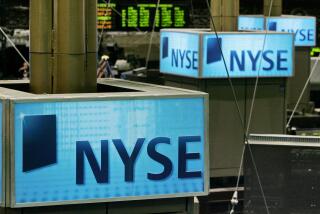Dividend Payouts on Steep Decline
- Share via
Reflecting in part the deep plunge in corporate profits, dividend payouts by the nation’s largest companies are expected to drop 6.6% this year overall--the steepest decline since 1942, Standard & Poor’s Corp. said Thursday.
Dwindling cash dividend payments are another blow to investors who already have suffered through the worst drop in stock prices since at least 1987.
Standard & Poor’s estimated total dividend payments by companies in the blue-chip S&P; 500 index will fall 6.6% for the year, after sliding 2.5% last year.
Amid depressed earnings, more major companies are opting not to raise quarterly dividend payments, while others are cutting them or skipping them altogether.
AT&T;, Edison International and Pacific Gas & Electric are among the dozens of major firms that have chopped or omitted dividends this year.
Also, S&P; said 764 companies raised dividends in the first half, down 12% from the same period last year and 22% from the same period in 1999.
“Companies are doing whatever they have to to conserve cash,” said Jay Wong, a portfolio manager at Payden & Rygel in Los Angeles.
The trend away from dividends reflects the dismal economy, changes in both corporate strategy and investor priorities, and the shifting makeup of the S&P; 500 index itself.
In their efforts to boost per-share earnings and long-term shareholder value, some companies have been slashing payouts and using that money to buy back stock or otherwise invest in their businesses, such as through acquisitions.
Many investors haven’t minded. For one thing, robust stock gains in the 1990s dwarfed dividend payments anyway. For another, the federal tax code vastly favors long-term capital gain income over dividend income, which is taxed at ordinary rates.
Meanwhile, some say the S&P; 500 isn’t what it used to be.
“The index used to be a blend between ‘growth’ and ‘value’ stocks,” said Bill Stromberg, director of equity research at mutual fund giant T. Rowe Price Group. Now, he argued, it is tilted more toward growth stocks such as AOL Time Warner and JDS Uniphase that pay no dividends.
Arnold Kaufman, editor of the S&P; Outlook newsletter in New York, said S&P; has continually updated the blue-chip index to “better reflect the changing nature of the economy.”
About three-quarters of S&P; 500 members now pay dividends, Kaufman said, compared with 80% a year ago and 95% in 1980.
Regardless, Stromberg said he expects dividends to rise again--in importance as well as in sheer dollars--if stock prices overall continue to struggle.
The current annualized dividend yield on the S&P; 500 is about 1.3%. For much of the post-World War II era, investors were accustomed to blue-chip dividend yields of 3% to 6%.
“When stocks were gaining 15% to 20% that little extra dividend more or less amounted to a rounding error,” Stromberg said. “But even a company’s 1% dividend could become much more noticeable now.”
As baby boomers age and shift their priorities from capital appreciation to current income, that also could spur renewed interest in dividends, he said.
More to Read
Inside the business of entertainment
The Wide Shot brings you news, analysis and insights on everything from streaming wars to production — and what it all means for the future.
You may occasionally receive promotional content from the Los Angeles Times.










